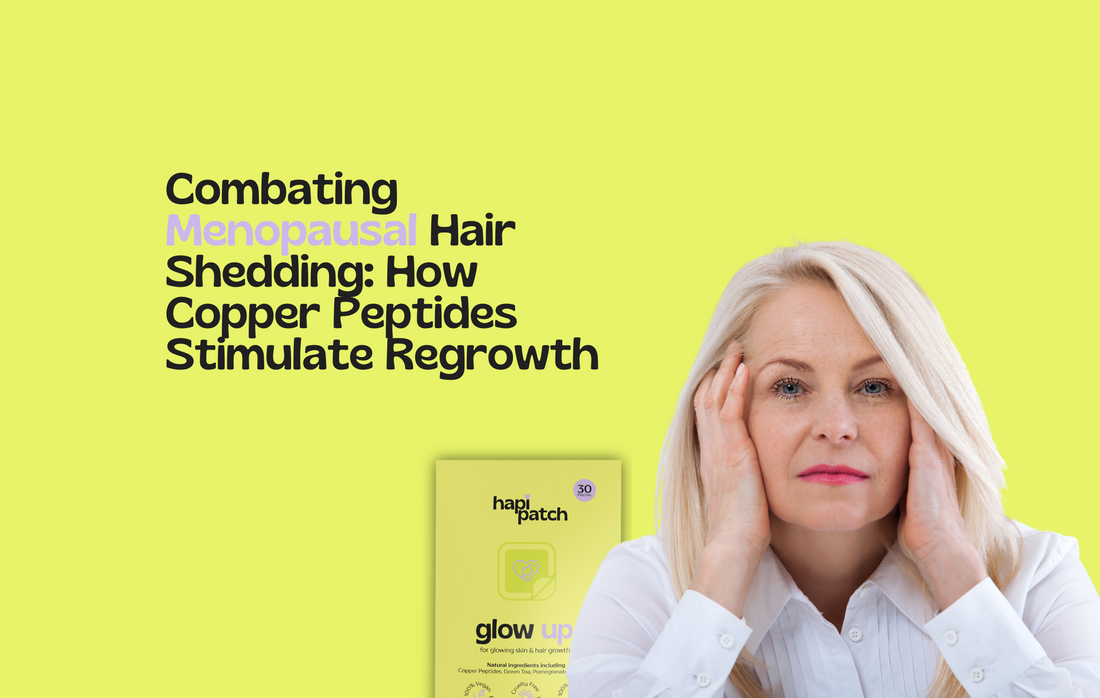Hair shedding is one of the most common and distressing symptoms women face during menopause. As hormone levels fluctuate, the hair’s growth cycle is disrupted, leading to excessive shedding and thinner hair. While shampoos and topical treatments are widely used, they often fail to provide long-lasting solutions. In this blog, we will explore how copper peptides, particularly Glow Up Copper Peptide Patches from hapi patch, can combat menopausal hair shedding by stimulating hair follicles and encouraging regrowth.
Why menopausal hair shedding happens
The hair growth cycle consists of three phases: anagen (growth), catagen (transition), and telogen (resting). Hormonal changes during menopause cause hair follicles to enter the telogen phase prematurely, leading to increased shedding. Here’s why:
- Decline in oestrogen: Oestrogen plays a key role in prolonging the anagen (growth) phase of hair. As oestrogen levels drop during menopause, hair follicles spend less time in the growth phase and enter the shedding phase faster.
- Androgen dominance: As oestrogen decreases, androgens such as DHT become more dominant. DHT shrinks hair follicles, causing them to shed hair strands before they have a chance to grow fully.
- Stress and inflammation: Hormonal changes can also increase stress and scalp inflammation, further exacerbating hair shedding by weakening hair follicles.
Why shampoos and topical treatments aren’t effective
Many women attempt to combat menopausal hair shedding with shampoos and topical treatments. However, these methods often fall short for a few reasons:
- Superficial action: Shampoos and topical serums only clean the scalp or add volume temporarily. They don’t reach deep enough to stimulate the hair follicles where growth occurs.
- Limited absorption: Hair follicles, which lie beneath the surface, require active ingredients to penetrate deeply. Shampoos do not provide long-lasting absorption into the skin.
- Lack of sustained stimulation: Hair regrowth requires continuous stimulation, something shampoos can’t offer due to their brief application time and surface-level action.
How copper peptides help reduce menopausal hair shedding
Copper peptides, especially GHK-Cu, are scientifically proven to reduce hair shedding and promote regrowth by targeting hair follicles directly. Here’s how they help:
- Extending the anagen phase: GHK-Cu keeps hair follicles in the growth phase for longer, preventing premature shedding.
- Blocking DHT: Copper peptides help reduce the effects of DHT, which causes hair follicles to shrink and shed hair prematurely. By blocking DHT, GHK-Cu protects hair follicles and promotes healthier, thicker growth.
- Improving blood flow: Copper peptides stimulate blood circulation in the scalp, delivering essential nutrients and oxygen to hair follicles, which strengthens them and reduces shedding.
Why transdermal delivery is the best option
To effectively combat menopausal hair shedding, a solution needs to reach the bloodstream and target hair follicles from within. Transdermal patches like Glow Up Copper Peptide Patches are the most effective way to deliver copper peptides directly to the hair follicles.
- Deeper penetration: Glow Up patches allow GHK-Cu to penetrate deep into the scalp, reaching the hair follicles where shedding originates.
- Sustained release: The patches provide a controlled release of copper peptides over several hours, ensuring continuous support for the hair follicles.
- Direct bloodstream delivery: Unlike shampoos, transdermal patches bypass the digestive system, providing direct delivery of active ingredients to the bloodstream, which boosts effectiveness.
Why Glow Up Copper Peptide Patches are ideal for menopausal hair shedding
Glow Up Copper Peptide Patches from hapi patch offer a proven solution for reducing menopausal hair shedding and promoting regrowth. Here’s why:
- Targeted treatment: Glow Up patches can be applied directly to areas of thinning, ensuring that copper peptides are delivered precisely where they are needed.
- 4-layered matrix design for optimal absorption: The patches deliver copper peptides consistently over several hours, ensuring long-lasting stimulation of the hair follicles.
- Non-hormonal, gentle solution: Copper peptides offer a non-hormonal treatment for menopausal hair shedding, making them safe for long-term use without side effects.
Real results: Before and after success stories
Women across the UK have seen significant reductions in hair shedding after using Glow Up Copper Peptide Patches. Here are some of their success stories:
- Emma, age 51: "I was losing clumps of hair every time I washed it. The Glow Up patches have made such a difference. My hair has stopped shedding as much, and I’m seeing new growth in the thinning areas."
- Tina, age 49: "After trying so many shampoos, I gave Glow Up patches a chance, and they’ve been amazing. The shedding has slowed down, and my hair feels thicker already."
FAQs About Copper Peptides for Menopausal Hair Shedding
Why does hair shedding increase during menopause?
The decline in oestrogen causes hair follicles to spend less time in the growth phase, leading to increased shedding. Androgens like DHT also contribute to hair thinning by shrinking hair follicles.
Can copper peptides help reduce hair shedding during menopause?
Yes, copper peptides extend the growth phase of hair follicles and block DHT, which helps reduce shedding and promotes hair regrowth.
How long does it take to see results with copper peptides?
Many women start noticing improvements in hair shedding within 2-3 months of consistent use.
Are copper peptides safe for long-term use?
Yes, copper peptides are non-toxic and safe for long-term use to address hair shedding during menopause.
How do Glow Up Copper Peptide Patches work for menopausal hair shedding?
Glow Up patches deliver GHK-Cu directly to the scalp, helping to reduce shedding and stimulate hair follicles for thicker, healthier hair.

